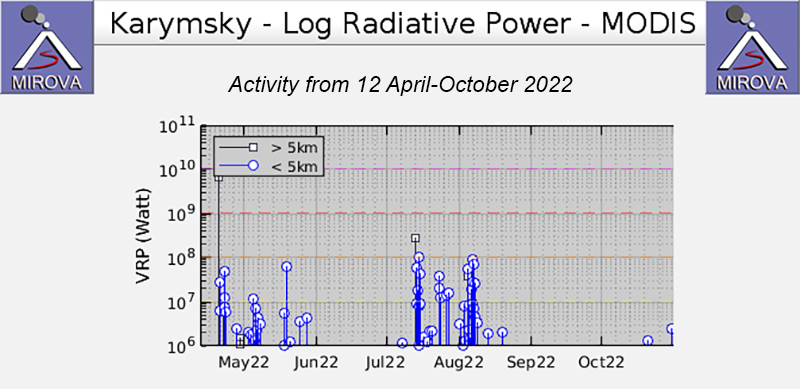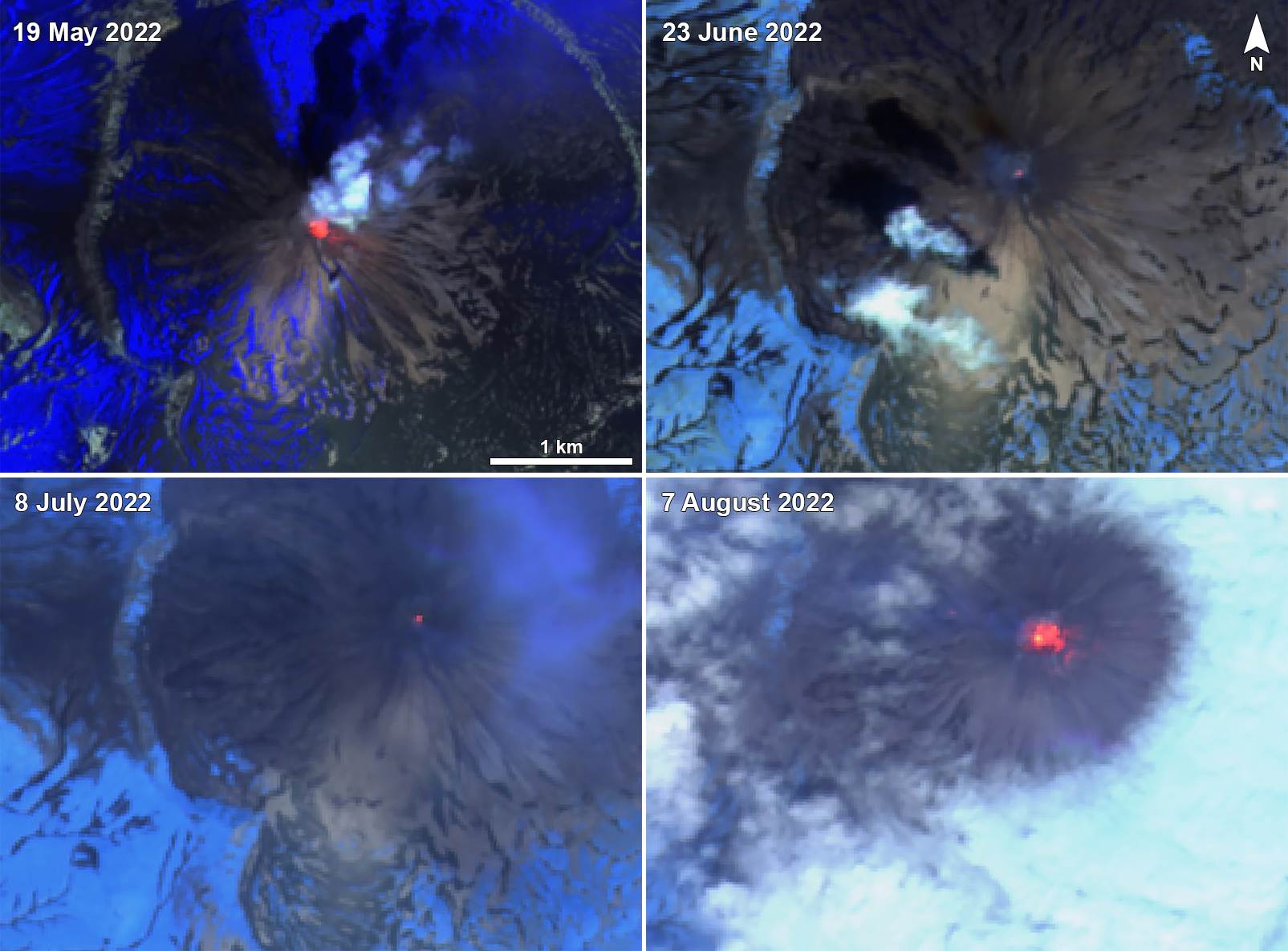Report on Karymsky (Russia) — November 2022
Bulletin of the Global Volcanism Network, vol. 47, no. 11 (November 2022)
Managing Editor: Edward Venzke.
Edited by Kadie L. Bennis.
Karymsky (Russia) Intermittent ash explosions until early August 2022; ongoing thermal anomalies and steam plumes
Please cite this report as:
Global Volcanism Program, 2022. Report on Karymsky (Russia) (Bennis, K.L., and Venzke, E., eds.). Bulletin of the Global Volcanism Network, 47:11. Smithsonian Institution.
Karymsky
Russia
54.049°N, 159.443°E; summit elev. 1513 m
All times are local (unless otherwise noted)
Karymsky, located in Kamchatka’s eastern volcanic zone, was constructed within a 5-km-wide caldera during the early Holocene. The latest eruptive period began about 500 years ago, following a 2,300-year quiescence. Much of the cone is mantled by lava flows less than 200 years old. Historical eruptions have been Vulcanian or Vulcanian-Strombolian with moderate explosive activity and occasional lava flows from the summit crater. The most recent eruption period began during April 2020 and has consisted of strong ash explosions, ashfall, and thermal activity. This report covers activity during May through October 2022 that was characterized by intermittent explosions, ash plumes, and thermal activity using daily, weekly, and special reports from the Kamchatka Volcanic Eruptions Response Team (KVERT) and satellite data.
Moderate ash explosions were detected during May, accompanied by frequent thermal anomalies. Explosions visible in satellite data during 4-5 May generated ash plumes to 2.5-3.2 km altitude and drifted 15-60 km SW (figure 67). On 12 May explosions produced an ash plume that rose to 6 km altitude and drifted as far as 25-135 km WNW and NW. On 14 May explosions generated ash plumes to 5.7 km altitude and extended 28 km NE. During 17-18 May explosions sent ash to 3-3.5 km altitude and drifted 18-20 km ENE and NE. On 19 May explosions produced ash plumes that rose to 6.7-8 km altitude and drifted as far as 200-370 km E. During June, activity was relatively low; satellite data showed a thermal anomaly on most days over the volcano and occasional gas-and-steam emissions were visible (figure 68).
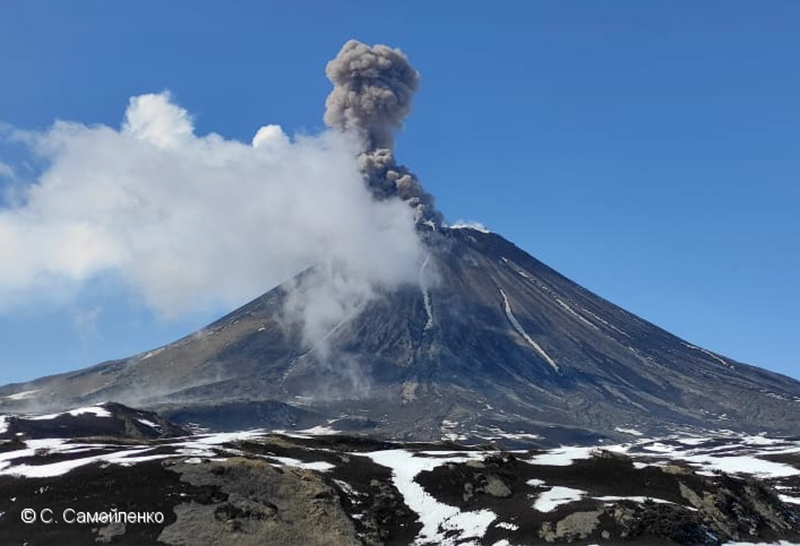 |
Figure 67. Photo of an ash plume that rose to 3.2 km altitude at Karymsky on 4 May 2022. Courtesy of S. Samoylenko, KVERT. |
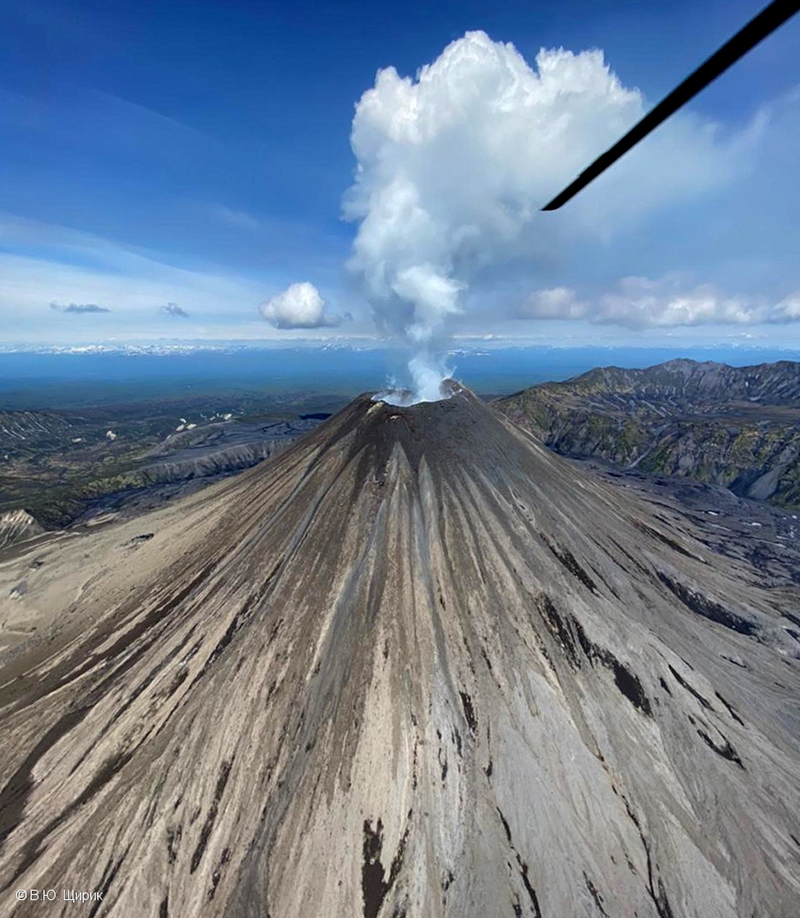 |
Figure 68. Photo of fumarolic activity rising above Karymsky on 16 June 2022. Courtesy of V. Shchirik, KVERT. |
Activity continued during July, with a frequent thermal anomaly detected and intermittent ash plumes. Satellite data showed that during 13-14 July explosions produced ash plumes that rose to 8.5-11 km altitude and drifted 73-360 km SW. KVERT reported that after the eruption at 2250 on 13 July the ash cloud continued to be observed at a distance of 350 km SW. On 15 July moderate explosive activity produced an ash plume that extended as far as 45-200 km S and SE and during 29-31 July ash plumes rose to 5 km altitude and drifted 43 km SE and 30 km NE. On 31 July explosions produced ash plumes to 8 km altitude and drifted 57 km E and SE.
Similar activity was reported during August. On 2 August satellite data showed that an ash plume rose to 5.5 km altitude (4 km above the summit) and drifted about 12-230 km SSW (figure 69). During 6, 7, and 8 August ash plumes initially extended as far as 28 km NE, 18 km WNW, and 27 km W, respectively. The resulting ash clouds extended as far as 550 km SW and SE. A thermal anomaly was identified during the first week of August. KVERT reported that strong explosive events had stopped on 7 August.
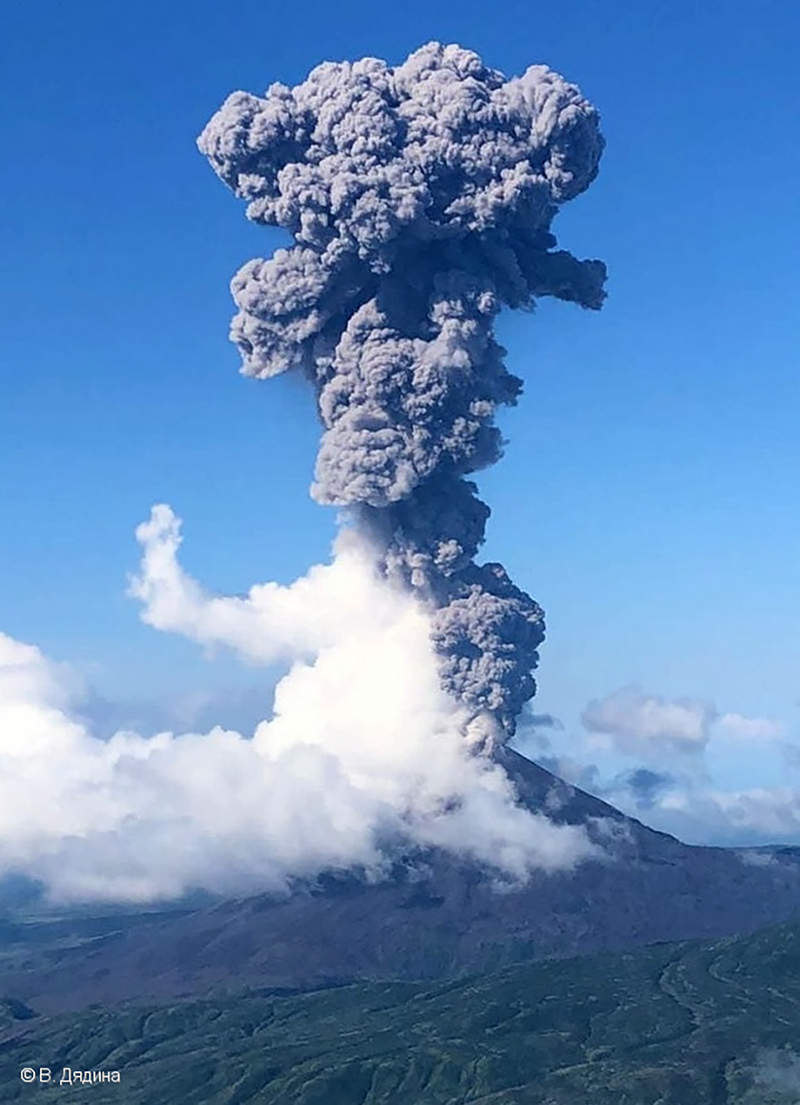 |
Figure 69. Photo of an explosive event at Karymsky at 2144 UTC on 2 August 2022. The ash plume rose to 5.5 km altitude, about 4 km above the summit. Courtesy of V. Dyadina, KVERT. |
Thermal anomalies continued to be detected during 12-13, 16, 18-19, 22, and 24-25 August; on other days the volcano was obscured by weather clouds. After these events, the strength of the thermal anomaly gradually decreased. Activity during September was dominated by a weak thermal anomaly on clear weather days, based on satellite data. Gas-and-steam emissions and a weak thermal anomaly occurred throughout October (figure 70). Satellite data showed that a thermal anomaly was visible at 0332 on 17 October.
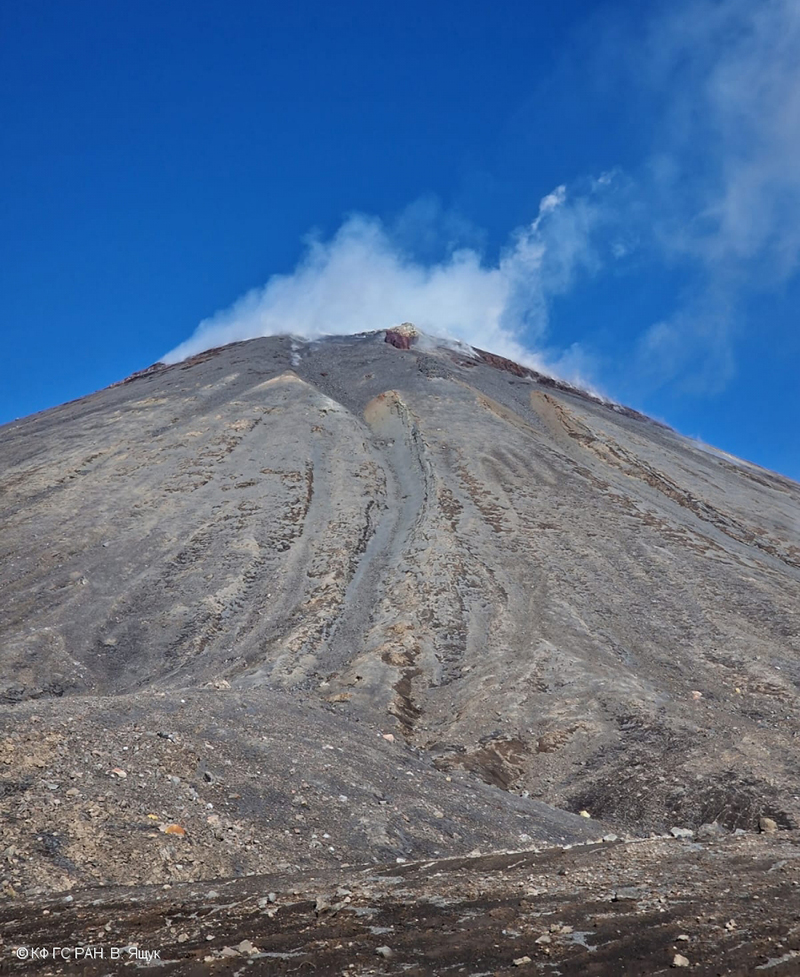 |
Figure 70. Photo of white gas-and-steam emissions at Karymsky on 11 October 2022. Courtesy of V. Yaschuk, KB GS RAS, KVERT. |
MIROVA (Middle InfraRed Observation of Volcanic Activity) analysis of MODIS satellite data showed pulses of thermal activity during May and July-August (figure 71). Two low-power thermal anomalies were detected near the end of October. A total of six thermal hotspots were detected on 13, 14, 15, and 23 July, and 6 August, according to data from the MODVOLC thermal algorithm. On clear weather days, occasional thermal anomalies of variable intensity were visible in Sentinel-2 infrared satellite images; on 19 May and 7 August notably strong thermal anomalies were accompanied by incandescent avalanches of material on the SE flank (figure 72).
Geological Summary. Karymsky, the most active volcano of Kamchatka's eastern volcanic zone, is a symmetrical stratovolcano constructed within a 5-km-wide caldera that formed during the early Holocene. The caldera cuts the south side of the Pleistocene Dvor volcano and is located outside the north margin of the large mid-Pleistocene Polovinka caldera, which contains the smaller Akademia Nauk and Odnoboky calderas. Most seismicity preceding Karymsky eruptions originated beneath Akademia Nauk caldera, located immediately south. The caldera enclosing Karymsky formed about 7600-7700 radiocarbon years ago; construction of the stratovolcano began about 2000 years later. The latest eruptive period began about 500 years ago, following a 2300-year quiescence. Much of the cone is mantled by lava flows less than 200 years old. Historical eruptions have been vulcanian or vulcanian-strombolian with moderate explosive activity and occasional lava flows from the summit crater.
Information Contacts: Kamchatka Volcanic Eruptions Response Team (KVERT), Far Eastern Branch, Russian Academy of Sciences, 9 Piip Blvd., Petropavlovsk-Kamchatsky, 683006, Russia (URL: http://www.kscnet.ru/ivs/kvert/); MIROVA (Middle InfraRed Observation of Volcanic Activity), a collaborative project between the Universities of Turin and Florence (Italy) supported by the Centre for Volcanic Risk of the Italian Civil Protection Department (URL: http://www.mirovaweb.it/); Hawai'i Institute of Geophysics and Planetology (HIGP) - MODVOLC Thermal Alerts System, School of Ocean and Earth Science and Technology (SOEST), Univ. of Hawai'i, 2525 Correa Road, Honolulu, HI 96822, USA (URL: http://modis.higp.hawaii.edu/); Sentinel Hub Playground (URL: https://www.sentinel-hub.com/explore/sentinel-playground).


